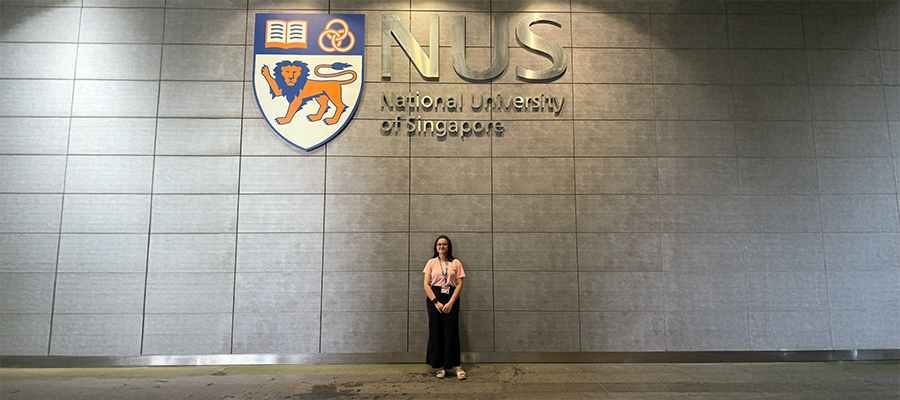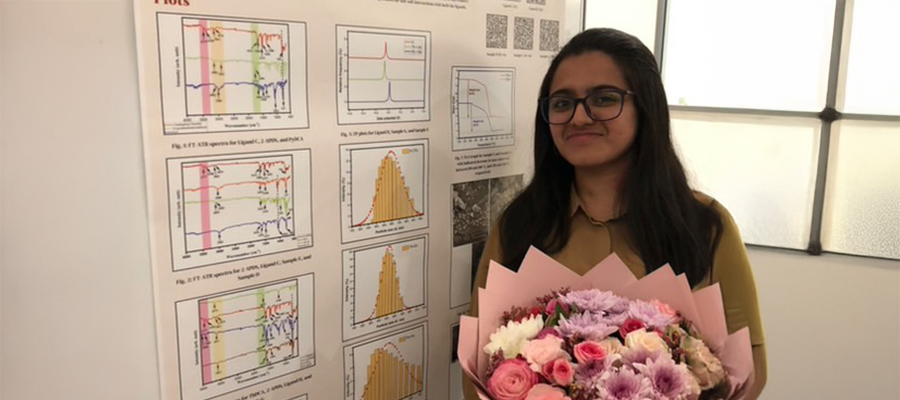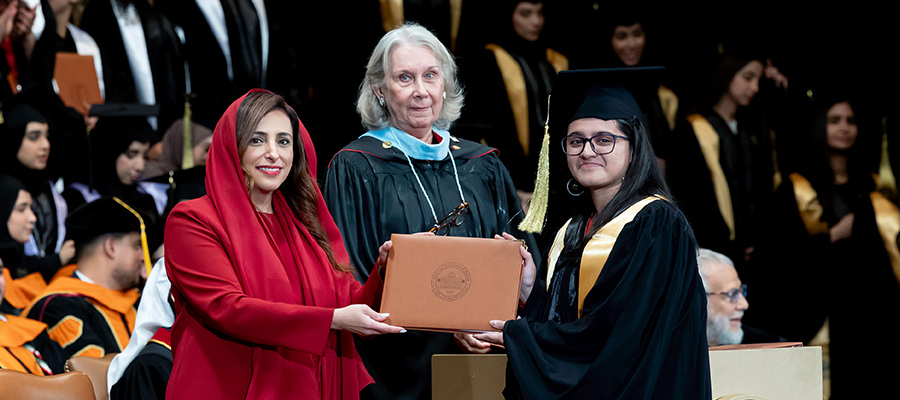- About
- Admissions
- Study at AUS
- Prospective Students
- Bachelor's Degrees
- Master's Degrees
- Doctoral Degrees
- Admission Publications
- International Students
- Contact Admissions
- Grants and Scholarships
- Sponsorship Liaison Services
- Testing Center
- New Undergraduate Student Guide
- Undergraduate Orientation
- New Graduate Student Guide
- Graduate Orientation
- File Completion
- Payment Guide
- Students with Disabilities
- Executive and Continuing Education
- Academics
- Life at AUS
- Research
- Publications
- Contact Us
- Apply Now
- .

From AUS to NUS: CAS graduate goes straight from Bachelor's to PhD
Chemistry graduate Durga Chandrashekhar talks about her bold leap from an AUS undergraduate degree to doctoral research in Singapore
For many students, the path to a doctoral program begins with a master’s degree. But for American University of Sharjah (AUS) graduate Durga Chandrashekhar, her time in the College of Arts and Sciences gave her the confidence and preparation to leap directly into a PhD in Chemistry at the National University of Singapore (NUS).
Chandrashekhar credits the research-intensive culture of AUS with shaping her ambitions. “Being a research assistant in the Department of Mathematics and Statistics and completing my senior research courses in the Department of Biology, Chemistry and Environmental Sciences definitely increased my inclination toward a research-driven career,” she said. “The vast majority of the courses I took had a research component, and this really allowed me to apply the theoretical frameworks we studied and bring this knowledge beyond the classroom.”
Her connection to Singapore also played a role. “Having lived there during middle school, I already knew how dynamic the environment was, both culturally and academically,” she explained. “When I had the chance to e-meet the supervisor I’m now working with, our discussion made me even more excited to join NUS.”

The PhD application process itself was a turning point. “The first and most important step was writing cold emails to potential advisors—essentially marketing myself, my ideas and what I hoped to achieve,” she recalled. “It wasn’t easy. Some advisors never replied, and others gave short feedback, but with each message I learned how to refine my approach. Eventually, I had an interview where I presented my AUS research experience and my proposed PhD direction—and the two of us clicked.”
Her research journey took an unexpected turn during her first year at AUS, sparked by a conversation with Dr. Stephen Chan in the Department of Mathematics and Statistics.
“Back then, I had minimal knowledge in statistics or financial econometrics, but one short conversation about his research changed everything,” she said. “Dr. Chan has been an incredible mentor, guiding me through the smallest aspects of academic research. We’ve now worked together on multiple projects spanning NFTs, cryptocurrencies, commodity markets and blockchain crime for close to two years.”
Through Dr. Chan’s network, Chandrashekhar also connected with Yield Guild Games and the MSCA Industrial Doctoral Network on Digital Finance. “These partnerships really opened my eyes to the practical side of academic research,” she said. “They showed me how what we do in theory can have real-world applications in areas like digital finance and gaming economies.”

Her work has already reached an international stage. “Presenting at conferences like the Conference on Computational and Financial Econometrics (CFE) and the International Conference on Computational and Methodological Statistics (CMStatistics) in Berlin and the International Congress on Mathematical Software ICMS 2025 was truly exciting,” she said. “Being surrounded by incredible minds with years of experience was humbling, but it was also a huge learning opportunity to see mathematics and statistics applied across economics, environmental modelling, biology and even chemistry.”
Chandrashekhar’s published paper in Physica A provides a comprehensive review of the metaverse and statistical analyses of prominent gaming NFTs.
“We observed heavy-tailed returns, volatility clustering and mean-reverting volatility, which have major implications for pricing models and predicting market behavior,” she explained. “Our analysis provides valuable insights for both academics and industry.”
Now at NUS, she sees strong parallels with AUS. “Both institutions really push us to advance knowledge in niche areas and encourage us to think independently,” she said. “The main difference is the level of independence expected of us as PhD students, but that’s part of the journey.”

Looking ahead, Chandrashekhar sees her doctoral work as the foundation of a lifelong research career. “This journey is all about becoming more independent,” she said. “I do plan to enter industry at some stage, but eventually I want to return to academia to inspire future minds to continue researching.”
Her advice for AUS students considering unconventional paths reflects her own bold approach:
“Embrace your individual strengths. There is no one ‘correct’ pathway set in stone that leads to success—what matters most is that you enjoy what you do.”
For more about AUS’ Bachelor of Science in Chemistry and Biochemistry, visit www.aus.edu/cas/department-of-biology-chemistry-and-environmental-scienc...

